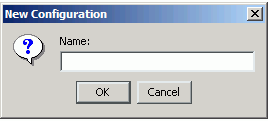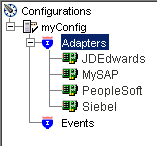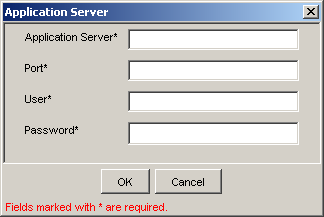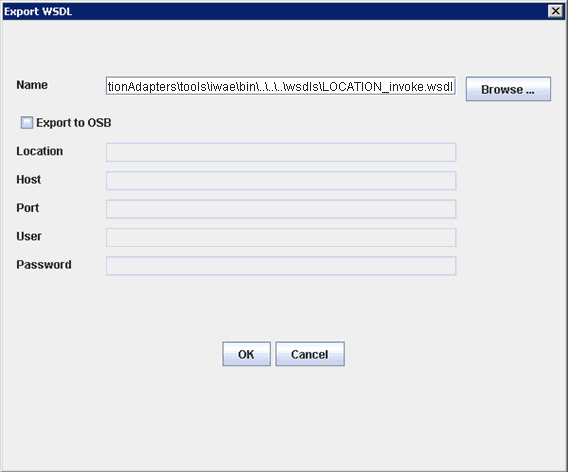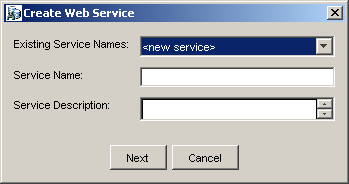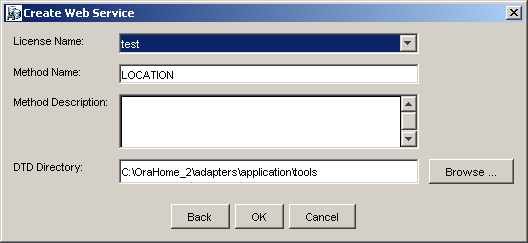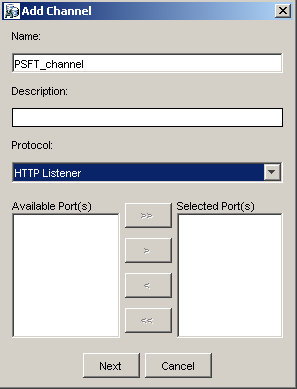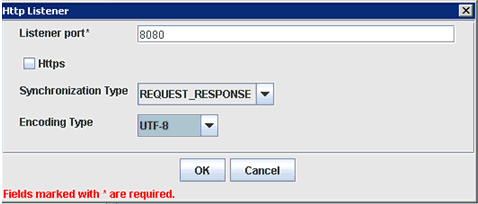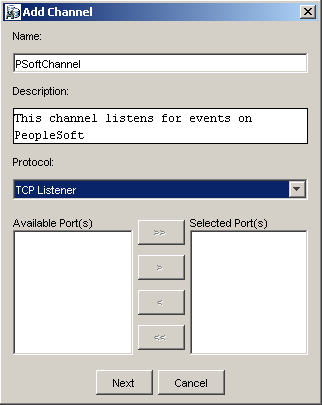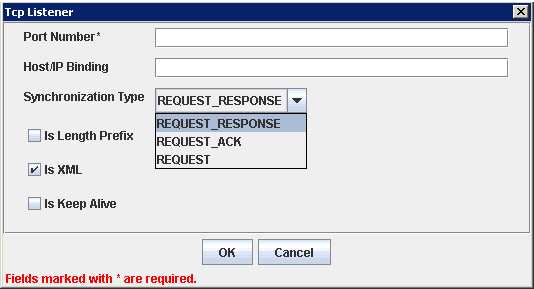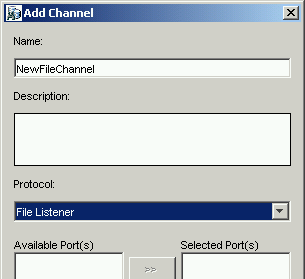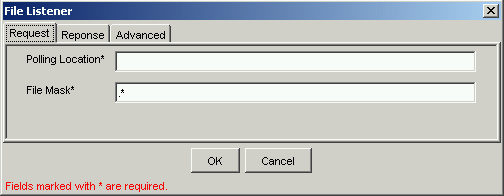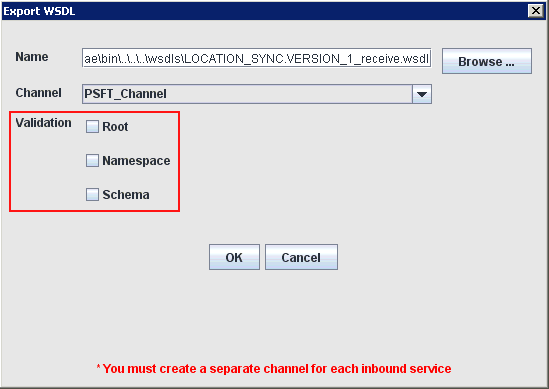2 Configuring Oracle Application Adapter for PeopleSoft
Oracle Adapter Application Explorer (Application Explorer) enables the processing of Component Interfaces and Messages.
External applications that access PeopleSoft through the adapter use either XML schemas or Web services to pass data between the external application and the adapter. You can use Application Explorer to create the required XML schemas and Web services.
This chapter contains the following topics:
Starting Application Explorer
To start Application Explorer:
-
Ensure that Oracle WebLogic Server is started, which is where Application Explorer is deployed.
-
Click the Windows Start menu, select All Programs, Oracle Application Adapters, and then click Application Explorer, as shown in Figure 2-1.
Figure 2-1 Oracle Application Adapters Program Menu

Description of "Figure 2-1 Oracle Application Adapters Program Menu"
Application Explorer is displayed.
Alternatively, you can run the ae.bat file, which is located in the following directory to start Application Explorer:
Oracle SOA Suite:
<ORACLE_HOME>\soa\thirdparty\ApplicationAdapters\tools\iwae\bin\ae.batOracle Service Bus (OSB):
<OSB_HOME>\Oracle_OSB1\3rdparty\ApplicationAdapters\tools\iwae\bin\ae.batIt is a good practice to create a shortcut for the ae.bat file on your desktop.
If you are using a UNIX or Linux platform, then you can start Application Explorer by using the iwae.sh file.
Application Explorer starts. You are ready to define new targets to your PeopleSoft system.
Note:
Before you run the iwae.sh file on UNIX or Linux platforms, the permissions must be changed. For example:chmod +x iwae.sh
Configuring Repository Settings
A repository holds information about configuration details, adapter targets, channels, and other configuration information. For more information on how to configure BSE and J2CA repository settings, see the Oracle Fusion Middleware Application Adapters Installation Guide for Oracle WebLogic Server (Section 2.8.4, "Configuring the Database Repository").
Creating a Repository Configuration
Before you use Application Explorer with Oracle Application Adapter for PeopleSoft, you must create a repository configuration. You can create two kinds of repository configurations, Web services and J2CA, depending on the container to which the adapter is deployed. During design time, the repository is used to store metadata created when using Application Explorer to configure adapter connections, browse EIS objects, configure services, and configure listeners to listen for EIS events. The information in the repository is also referenced at run-time.
Web services and BSE refer to the same type of deployment. For more information, see "Adapter Features".
This section contains the following topics:
Creating a Configuration for BSE
To create a repository configuration for BSE using Application Explorer, you must first define a new configuration.
Defining a New Configuration for BSE
To define a new configuration for BSE:
-
Start the Application Explorer.
-
Right-click Configurations and select New.
The New Configuration dialog is displayed, as shown in Figure 2-2.
-
Enter a name for the new configuration (for example, myConfig) and click OK.
The New Configuration dialog is displayed, as shown in Figure 2-3.
Figure 2-3 New Configuration Dialog - Service Provider List and iBSE URL

Description of "Figure 2-3 New Configuration Dialog - Service Provider List and iBSE URL"
-
In the BSE URL field, accept the default URL or replace it with a different URL with the following format:
http://host name:port/ibse/IBSEServlet
Where
host nameis the system where Oracle WebLogic Server resides andportis the HTTP port for a managed Oracle WebLogic Server (for example, soa_server1). -
Click OK.
A node representing the new configuration appears beneath the root Configurations node, as shown in Figure 2-4.
Figure 2-4 New Configuration Node - myConfig

Description of "Figure 2-4 New Configuration Node - myConfig"
Creating a Configuration for J2CA
To create a configuration for Oracle Adapter J2CA using Application Explorer, you must first define a new configuration.
This section contains the following topic:
To define a new configuration for J2CA:
-
Start the Application Explorer.
-
Right-click Configurations and select New.
The New Configuration dialog is displayed, as shown in Figure 2-5.
-
Enter a name for the new configuration (for example, myConfig) and click OK.
-
Click OK.
A node representing the new configuration appears beneath the root Configurations node, as shown in Figure 2-6.
Figure 2-6 New Configuration Node - myConfig

Description of "Figure 2-6 New Configuration Node - myConfig"
The Oracle Adapter J2CA configuration folder is stored in:
<ADAPTER_HOME>\soa\thirdparty\ApplicationAdapters\config\configuration_name
Where configuration_name is the name of the configuration you created (for example, myConfig).
HTTP Repository Connection
J2CA users can create an HTTP repository connection, which enables them to generate and store WSDL documents remotely. Perform the following steps to create an HTTP repository connection in Application Explorer. To use the HTTP repository, ensure that the iwjcaivp test tool(jca-app-adapter-test) is successfully deployed and running.
-
Start the Application Explorer.
-
Right-click the Configurations node in the left pane and select New.
The New Configuration dialog opens.
-
Type a name for the configuration and click OK.
-
Select JCA from the Service Provider list box and enter an HTTP target value in the Home field.
Use the following format for the HTTP target value:
http://host name:port/iwafjca/JCAServlet
For example:
http://iwserv14:8001/iwafjca/JCAServlet
-
Click OK.
The new HTTP repository connection is added to the Configurations node.
Once you connect to the remote server, you can create new Adapter targets, generate WSDL documents, and store them in the remote server.
Note: When you configure an Adapter target with the J2CA HTTP repository, you are not required to restart the Oracle WebLogic Server for run time purposes.
Connecting to a BSE or J2CA Configuration
To connect to a new configuration:
-
Right-click the configuration to which you want to connect, for example, myConfig.
-
Select Connect.
Nodes appear for Adapters, Events, and Business Services (also known as Web services). The Business Services node is only available for BSE configurations. If you are connected to a J2CA configuration, then the Business Services node is not shown.
Events are not applicable when using a BSE configuration. You can configure events using a J2CA configuration only.
An example of a BSE configuration named myConfig, as shown in Figure 2-7.
Figure 2-7 New BSE Configuration - myConfig Node

Description of "Figure 2-7 New BSE Configuration - myConfig Node"
-
Use the Adapters folder to create inbound interaction with PeopleSoft. For example, you use the PeopleSoft node in the Adapters folder to configure a service that updates PeopleSoft.
-
Use the Events folder (available for J2CA configurations only) to configure listeners that listen for events in PeopleSoft.
-
Use the Business Services folder (available for BSE configurations only) to test Web services created in the Adapters folder. You can also control security settings for the Web services by using the security features of the Business Services folder.
You are now ready to define new targets to PeopleSoft.
Establishing a Connection (Target) for PeopleSoft
Part of the application definition includes adding a target for Oracle Application Adapter for PeopleSoft. Setting up the target in Application Explorer requires information that is specific to the target.
To browse PeopleSoft business objects, you must create a target for the system you intend to use. The target serves as your connection point and is automatically saved after you create it. You must establish a connection to this system every time you start Application Explorer or after you disconnect from the system.
When you launch Application Explorer, the left pane displays (as nodes) the application systems supported by Application Explorer, based on the adapters that are installed.
This section contains the following topics:
Defining a Target to PeopleSoft
To connect to PeopleSoft for the first time, you must define a new target. Oracle Application Adapter for PeopleSoft supports PeopleSoft standard security, in addition to component interface-level security. Once connected to the PeopleSoft application server, application security is managed by user ID, roles and privileges. For more information on PeopleSoft application security, see the appropriate PeopleSoft documentation.
When you define a new target, you must restart the Oracle WebLogic Server to update the repository for run time purposes.
To define a target:
-
In the left pane, expand the Adapters node.
The applications systems supported by Application Explorer appear as nodes based on the adapters that are installed, as shown in Figure 2-8.
-
Right-click the PeopleSoft node and select Add Target.
The Add Target dialog is displayed. Provide the following information:
-
In the Name field, enter a descriptive name for the target, for example, PSoftTarget.
-
In the Description field, enter a description for the target (optional).
-
From the Target Type list, select Application Server.
This is the only possible value for target type.
-
-
Click OK.
The Application Server dialog is displayed, as shown in Figure 2-9. You must specify connection information for PeopleSoft and the application server that is hosting PeopleSoft.
Provide the following information:
-
In the Application Server field, enter the host name or IP address for the computer that is hosting the PeopleSoft application.
-
In the Port field, enter the port number where the PeopleSoft application is listening.
-
In the User field, enter a valid user ID for the PeopleSoft application.
-
In the Password field, enter a valid password for the PeopleSoft application.
-
-
Click OK.
In the left pane, the new target (PSoftTarget) appears the PeopleSoft node, as shown in Figure 2-10.
Figure 2-10 Disconnected PeopleSoft Target Node

Description of "Figure 2-10 Disconnected PeopleSoft Target Node"
Connecting to a Defined PeopleSoft Target
To connect to an existing target:
-
In the left pane, expand the Adapters node.
-
Expand the PeopleSoft node.
-
Click the target name (for example, PSoftTarget) under the PeopleSoft node.
The Connection dialog displays the values you entered for connection parameters.
-
Right-click the target name and select Connect.
The x icon disappears, indicating that the node is connected. A list of PeopleSoft business objects is displayed, as shown in Figure 2-11.
Managing a Target
Although you can maintain multiple open connections to different transaction processing systems, it is recommended that you disconnect from connections not in use. After you disconnect, you can modify an existing target.
You can modify the connection parameters when your system properties change. You also can delete a target. The following procedures describe how to disconnect from a target, edit a target, and delete a target.
This section contains the following topics:
Disconnecting from a Connection to PeopleSoft
To disconnect from a connection to PeopleSoft:
-
Expand the Adapters node.
-
Expand the PeopleSoft node.
-
Right-click the target to which you are connected (for example, PSoftTarget), and select Disconnect, as shown in Figure 2-12.
Disconnecting from PeopleSoft drops the connection with PeopleSoft, but the node remains.
The x icon appears, indicating that the node is disconnected, as shown in Figure 2-13.
Figure 2-13 Disconnected PeopleSoft Target Node

Description of "Figure 2-13 Disconnected PeopleSoft Target Node"
Modifying Connection Parameters
After you create a target for PeopleSoft using Application Explorer, you can edit any of the information that you provided previously.
When modify connection parameters for a defined target, you must restart the Oracle WebLogic Server to update the repository for run time purposes.
-
Verify that the target you want to edit is disconnected.
-
Right-click the target and select Edit, as shown in Figure 2-14.
The Application Server dialog displays the target connection information.
-
Change the properties in the dialog as required and click OK.
Deleting a Connection to PeopleSoft
You can delete a connection, rather than just disconnecting and closing it. When you delete the connection, the node disappears from the list of PeopleSoft connections in the left pane of Application Explorer.
When you delete a connection, you must restart the Oracle WebLogic Server to update the repository for run time purposes.
To delete a connection to PeopleSoft:
-
Locate the target you want to delete.
-
Right-click the target (for example, PsoftTarget), and select Delete, as shown in Figure 2-15.
Figure 2-15 PSoftTarget Node - Delete Option

Description of "Figure 2-15 PSoftTarget Node - Delete Option"
The node disappears from the list of available connections.
Viewing Application System Objects
After you are connected to PeopleSoft, Application Explorer enables you to explore and browse business object metadata. For example, Application Explorer enables you to view PeopleSoft Component Interface and Message metadata stored in the PeopleSoft business object repository.
For Component Interfaces(RPC), the adapter enables Delete, Insert, Query, Update, and Find.
To view application system objects:
-
Click the icon to the left of the target name, for example, PSoftTarget.
The target expands and the available system objects are displayed, as shown in Figure 2-16.
-
To expand the desired PeopleSoft repository node, click the icon to the left of the repository name, for example, Component Interfaces.
A list of PeopleSoft Component Interfaces appears. You can now generate schemas.
Note:
The Component Interfaces (RPC) node only displays the level 1 Component Interfaces.
Creating XML Schemas
After you browse the PeopleSoft business object repository, you can generate XML request and response schemas for the object you want to use with your adapter.
This section contains the following topics:
Creating XML Request and Response Schemas Against BSE
To create XML request and response schemas for a PeopleSoft Component Interface against a BSE implementation:
-
Expand the PeopleSoft node and then, expand the Component Interfaces node.
-
From the list of Component Interfaces, select LOCATION.
-
Click the Request Schema or Response Schema tab to view the request or response schema information.
The schema you selected is displayed.
After you browse the Component Interfaces and make a selection, the request and response XML schemas are automatically created for that Component Interface and stored in the repository you created.
Creating XML Request and Response Schemas Against the Oracle Adapter J2CA
To create XML request and response schemas for a PeopleSoft Component Interface against an Oracle Adapter J2CA implementation:
-
Expand the PeopleSoft node and then, expand the Component Interfaces node.
-
From the list of Component Interfaces, select LOCATION.
-
Click the Request Schema or Response Schema tab to view the request or response schema information.
The schema you selected is displayed.
After you browse the Component Interfaces and make a selection, the request and response XML schemas are automatically created for that Component Interface and stored in the repository you created.
Generating a WSDL (J2CA Configurations Only)
The Web Service Definition Language (WSDL) description of a service enables you to make the service available to other services within a host server. You use Application Explorer to create both request-response (outbound) and event notification (inbound) JCA services of the adapter.
Note:
The Create Inbound JCA Service (Event) option is only available when the selected node supports events.Note:
PeopleSoft Component Interfaces only support services. As a result, only outbound WSDL files can be generated.To generate a WSDL file for request-response service:
-
After you create a schema, right-click the respective object.
The options are displayed, as shown in Figure 2-17.
Figure 2-17 Create Outbound JCA Service (Request/Response) Option

Description of "Figure 2-17 Create Outbound JCA Service (Request/Response) Option"
-
Select Create Outbound JCA Service (Request/Response).
The Export WSDL dialog is displayed, as shown in Figure 2-18.
-
Accept the default name for the file.
The .wsdl file extension is added automatically. By default, the names of WSDL files generated for request-response services end with
_invoke, while those generated for event notification end with_receive. -
Click OK.
The procedure for generating WSDL for event notification is similar to request-response. To generate WSDL for event notification, you must first create a channel for every event.
Creating and Testing a Web Service (BSE Configurations Only)
You can create Web services (also known as a business service) using Application Explorer. The PeopleSoft Component Interface called LOCATION is used as an example in the following procedure.
Note:
In a J2EE Connector Architecture (J2CA) implementation of adapters, Web services are not available. When the adapters are deployed to use Oracle Adapter J2CA, the Common Client Interface provides integration services using the adapters.To create a Web service, perform the following steps:
-
Expand the PeopleSoft node and then the Component Interfaces node.
-
From the list of Component Interfaces, select LOCATION.
-
Right-click the node from which you want to create a business service and select Create Web Service, as shown in Figure 2-19.
The Create Web Service dialog is displayed, as shown in Figure 2-20.
You can add the business function as a method for a new Web service or as a method for an existing one. Perform the following steps:
-
-
From the Existing Service Names list, select either <new service> or an existing service.
-
If you are creating a new service, then specify a service name. This name identifies the Web service in the list of services under the Business Services node.
-
Enter a brief description for the service (optional).
-
-
-
Click Next.
The license and method dialog is displayed, as shown in Figure 2-21.
Perform the following steps:
-
In the License Name field, select one or more license codes to assign to the Web service. To select more than one, hold down the Ctrl key and click the licenses.
-
In the Method Name field, enter a descriptive name for the method.
-
In the Method Description field, enter a brief description of the method.
-
The DTD Directory field specifies a destination for your Web service. You may click Browse to change the default location.
-
-
Click OK.
Application Explorer switches the view to the Business Services node, and the new Web service appears in the left pane.
After a Web service is created, you can test it to ensure that it functions properly. A test tool is provided for testing the Web service.
To test a business service:
-
Click the Business Services node to access your Web services.
-
Expand the Services node.
-
Select the name of the business service you want to test.
The business service name appears as a link in the right pane.
-
In the right pane, click the named business services link.
The test option appears in a separate BSE Servlet page. If you are testing a Web service that requires XML input, then an input field appears.
-
Enter the appropriate input.
-
Click Invoke.
The BSE Servlet page displays the results.
If you test or execute a Web service using a third party XML editor, for example XMLSPY, then the user name and password values that you specify in the SOAP header must be valid and are used to connect to PeopleSoft. The user name and password values that you provided for PeopleSoft during target creation using Application Explorer are overwritten for this Web service request. The following is a sample SOAP header that is included in the WSDL file for a Web service:
<SOAP-ENV:Header>
<m:ibsinfo xmlns:m="urn:schemas-iwaysoftware-com:iwse">
<m:service>String</m:service>
<m:method>String</m:method>
<m:license>String</m:license>
<m:disposition>String</m:disposition>
<m:Username>String</m:Username>
<m:Password>String</m:Password>
<m:language>String</m:language>
</m:ibsinfo>
</SOAP-ENV:Header>
You can remove the <m:disposition> and <m:language> tags from the SOAP header, since they are not required.
Configuring an Event Adapter
Events are generated by activity in an application system. You can use events to trigger an action in your application. For example, PeopleSoft may generate an event when customer information is updated. If your application performs an action when this happens, then your application is a consumer of this event.
Note:
BSE configurations do not support events.After you create a connection to your application system, you can add events using Application Explorer. To create an event, you must create a channel.
Note:
If you are using a J2CA configuration, then you must create a new channel for every event object and select this channel when you generate WSDL. Creating a channel is required for J2CA configurations only.A channel represents configured connections to particular instances of back-end systems. For more information, see "Creating and Editing a Channel".
Creating and Editing a Channel
The following procedures describe how to create a channel for your event. All defined event ports must be associated with a channel.
When you create, modify, or delete a channel, you must restart the Oracle WebLogic Server to recognize the change and update the repository for run time purposes.
Note:
If using a J2CA configuration, then you must create a new channel for every event and select this channel when creating an inbound service. Creating a channel is required for J2CA configurations only.Creating a Channel Using Specific Protocols
You can create the following types of channels using Application Explorer:
-
HTTP
It is recommended to use HTTP channels with PeopleTools Version 8.4.
-
TCP
It is recommended to use TCP channels with PeopleTools Version 8.1.
-
File
It is recommended to use File channels for testing purposes only. Do not use File channels in a production environment.
Note:
Channels can be configured and started only on the system where the Oracle Application Adapter for PeopleSoft is installed. Configuring and starting a channel for a remote host is not supported.The following procedures explain how to create these channels.
Creating an HTTP Channel
To create an HTTP Channel:
-
Click the Events node.
-
Expand the PeopleSoft node.
The ports and channels nodes appear in the left pane.
-
Right-click Channels and select Add Channel.
The Add Channel dialog is displayed, as shown in Figure 2-22.
Provide the following information:
-
Enter a name for the channel, for example, PSFT_channel.
-
Enter a brief description.
-
From the Protocol list, select HTTP Listener.
-
-
Click Next.
The Http Listener dialog is displayed, as shown in Figure 2-23.
-
Enter the system information as specified in the following table:
Parameter Description Listener port Port on which to listen for PeopleSoft event data. Https For a secure HTTP connection, select the Https check box. This option is currently not supported.
Synchronization Type Choose from the following synchronization options: -
REQUEST_RESPONSE
-
REQUEST_ACK
Important: The PeopleSoft channel does not work if the synchronization type is set to REQUEST.
Encoding Type Choose an encoding type to be used from the list. By default, ASCII is selected. -
-
Click OK.
A summary pane is displayed, providing the channel description, channel status, and available ports. All the information is associated with the channel you created.The channel appears under the channels node in the left pane.
An X over the icon indicates that the channel is currently disconnected. You must start the channel to activate your event configuration.
Note:
If you are planning to integrate Oracle Application Adapter for PeopleSoft with BPEL inbound or Mediator inbound process components, then do not start the channel. The channel is managed by the run-time server after the BPEL or Mediator process component is deployed. If you start the channel from Application Explorer for testing and debugging purposes, then stop it before run-time (when working with BPEL or Mediator process components). -
Right-click the channel and select Start.
The channel you created becomes active. The X over the icon in the left pane disappears.
-
To stop the channel, right-click the channel and select Stop.
Creating a TCP Channel
-
Click the Events node.
-
Expand the PeopleSoft node.
The ports and channels nodes appear in the left pane.
-
Right-click Channels and select Add Channel.
The Add Channel dialog is displayed, as shown in Figure 2-24.
Perform the following steps:
-
Enter a name for the channel, for example, PSoftChannel.
-
Enter a brief description.
-
From the Protocol list, select TCP Listener.
-
-
The Tcp Listener dialog is displayed, as shown in Figure 2-25.
Provide the following information:
-
In the Port Number field, specify the port number for your TCP listener (required).
-
In the Host/IP Binding field, specify the host IP for your TCP listener (optional).
Note:
Channels can be configured and started only on the system where the Oracle Application Adapter for PeopleSoft is installed. Configuring and starting a channel for a remote host is not supported. -
From the Synchronization Type list, select from the following synchronization type options:
REQUEST_RESPONSE
REQUEST_ACK
REQUEST
Important: The PeopleSoft channel only works with one of these synchronization types.
-
Is Length Prefix check box: For PeopleSoft events that return data that is not in XML format. The TCP/IP event application must prefix the data with a 4-byte binary length field when writing data to the TCP/IP port.
-
Is XML check box: For PeopleSoft events that return data in XML format. No preparser is required.
-
Is Keep Alive check box: Maintains continuous communication between the event transaction and the channel.
-
-
The channel appears under the Channels node in the left pane, as shown in Figure 2-26.
Figure 2-26 Inactive PeopleSoft Channel Node

Description of "Figure 2-26 Inactive PeopleSoft Channel Node"
An X over the icon indicates that the channel is currently disconnected. You must start the channel to activate your event configuration.
Note:
If you are planning to integrate Oracle Application Adapter for PeopleSoft with BPEL inbound or Mediator inbound process components, then do not start the channel. The channel is managed by the run-time server after the BPEL or Mediator process component is deployed. If you start the channel from Application Explorer for testing and debugging purposes, then stop it before run-time (when working with BPEL or Mediator process components). -
Right-click the channel node and select Start.
The channel becomes active, as shown in Figure 2-27.
Figure 2-27 Active PeopleSoft Channel Node

Description of "Figure 2-27 Active PeopleSoft Channel Node"
The X over the icon disappears.
-
To stop the channel, right-click the connected channel node and select Stop.
The channel becomes inactive and an X appears over the icon.
Creating a File Channel
To create a channel for the File listener:
-
Click the Events node.
-
In the left pane, expand the PeopleSoft node.
The ports and channels nodes appear.
-
Right-click Channels and select Add Channel.
The Add Channel dialog is displayed, as shown in Figure 2-28.
Perform the following steps:
-
Enter a name for the channel, for example, NewFileChannel.
-
Enter a brief description (optional).
-
From the Protocol list, select File Listener.
-
-
Click Next.
-
The File Listener dialog is displayed, as shown in Figure 2-29.
Enter the system information as follows:
-
In the Request tab, enter values for the following parameters:
Parameter Description Polling Location Target file system location for the PeopleSoft XML file. File Mask File name to be used for the output file generated by the operation. -
In the Response tab, enter values for the following parameters:
Parameter Description Synchronization Type Choose from the following synchronization options: -
REQUEST_RESPONSE
-
REQUEST_ACK
Important: The PeopleSoft channel does not work if the synchronization type is set to REQUEST.
Response/Ack Directory Target file system location for the PeopleSoft XML file. -
-
In the Advanced tab, enter values for the following parameters:
Parameter Description Error directory Directory to which documents with errors are written. Poll interval (msec) Interval (in milliseconds) when to check for new input. The default is three seconds. Optional. Processing Mode Sequential indicates single processing of requests. Threaded indicates processing of multiple requests simultaneously.
Thread limit If you selected threaded processing, then indicate the maximum number of requests that can be processed simultaneously.
-
-
Click OK.
A summary pane is displayed, providing the channel description and channel status. All the information is associated with the channel you created.
The channel appears under the channels node in the left pane. An X over the icon indicates that the channel is currently disconnected. You must start the channel to activate your event configuration.
Note:
If you are planning to integrate Oracle Application Adapter for PeopleSoft with BPEL inbound or Mediator inbound process components, then do not start the channel. The channel is managed by the run-time server after the BPEL or Mediator process component is deployed. If you start the channel from Application Explorer for testing and debugging purposes, then stop it before run-time (when working with BPEL or Mediator process components). -
Right-click the channel and select Start.
The channel you created becomes active. The X over the icon in the left pane disappears.
-
To stop the channel, right-click the channel and select Stop.
Schema Validation
Root validation, namespace validation, and schema validation for inbound processing (events) are supported for the Oracle Application Adapter for PeopleSoft with 11.1.1.2.0 BPEL.
To validate inbound processing using the Oracle Application Adapter for PeopleSoft, perform the following steps. This procedure uses the LOCATION_SYNC.VERSION_1 PeopleSoft Message as an example for inbound processing.
-
Start Application Explorer.
-
Connect to the PeopleSoft target.
-
Expand the Messages node.
-
Verify that you have already created a channel for the PeopleSoft adapter.
-
Right-click the LOCATION_SYNC.VERSION_1 node and select Create Inbound JCA Service (event).
The Export WSDL dialog opens and includes three check boxes for Root, Namespace, and Schema validation, as shown in Figure 2-30.
-
Selection of multiple validation options is allowed.
-
Root validation is used to validate the root element in the inbound XML document.
-
Namespace validation is used to validate the namespace in the inbound XML document.
-
Schema validation is used to validate the inbound XML document with the schema in the WSDL document.
-
During run time, validation is processed based on the validation options that are selected.
-
If more than one validation option is selected, during run time if the first validation option fails, then the remaining validation options are not processed.
-
Root and namespace validations are considered modest levels of validation. Schema validation is a stricter validation level.
-
It is recommended to use root and namespace validation options together, unless the root element and namespace are different between the Messages in the PeopleSoft environment.
-
-
Generate the WSDL document and create the BPEL process.
-
Trigger the transactions (Messages) from the PeopleTools environment.
